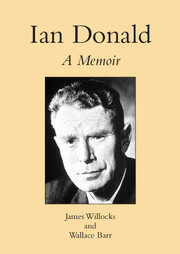Book contents
- Frontmatter
- Contents
- Illustrations
- Acknowledgments
- Miscellaneous Frontmatter
- Preface
- 1 Early life and training
- 2 London 1946—54
- 3 Appointment to the Glasgow Chair
- 4 Glasgow obstetrics in the Fifties
- 4 Sharing Enthusiasm: A textbook – and a teacher – with a difference
- 5 The Western Infirmary Wards G9 and 10
- 6 The cutting edge – in the operating theatre
- 7 The Queen Mother's Hospital
- 8 Science and Serendipity: Ultrasound takes off
- 9 Home life and hobbies
- 10 “Naught for your comfort”: social reform and medical ethics in a changing world
- 11 “At the receiving end”: courage and faith
- 12 “The evening cometh”: international fame, continued battle with illness and home happiness in retirement
- Sources
- Index
- Plate section
6 - The cutting edge – in the operating theatre
Published online by Cambridge University Press: 05 February 2014
- Frontmatter
- Contents
- Illustrations
- Acknowledgments
- Miscellaneous Frontmatter
- Preface
- 1 Early life and training
- 2 London 1946—54
- 3 Appointment to the Glasgow Chair
- 4 Glasgow obstetrics in the Fifties
- 4 Sharing Enthusiasm: A textbook – and a teacher – with a difference
- 5 The Western Infirmary Wards G9 and 10
- 6 The cutting edge – in the operating theatre
- 7 The Queen Mother's Hospital
- 8 Science and Serendipity: Ultrasound takes off
- 9 Home life and hobbies
- 10 “Naught for your comfort”: social reform and medical ethics in a changing world
- 11 “At the receiving end”: courage and faith
- 12 “The evening cometh”: international fame, continued battle with illness and home happiness in retirement
- Sources
- Index
- Plate section
Summary
In the operating theatre
Prior to the Second World War, gynaecological surgery fell within the province of the general surgeon, who confined himself to the removal of large pelvic tumours, with or without the uterus, and to the repair of damage caused by prolonged labours or traumatic deliveries. However, during the immediate post-war years, gynaecology emerged as a separate subject and was linked with midwifery, to be recognised as obstetrics and gynaecology.
This change was facilitated by the establishment in London of the Royal College of Obstetricians and Gynaecologists, which laid down rules for the training, examination and graduation of those doctors who specialised in this subject. In medical schools it was then taught as a separate part of the curriculum to be undertaken in the later stages of the course and incorporated in the Final Examination with medicine and surgery.
In these early years, London was the principal teaching centre where the leading exponents of the subject worked in famous teaching hospitals and names like Victor Bonney, Comyns Berkeley and “Joe”Wrigley were attracting attention from all over the world. Bonney, in particular, was notable for his book which described the full range of gynaecological operative procedures, beautifully illustrated with pencil drawings by his own hand.
When Donald came to the Chair in Glasgow in 1954, he was fortunate to have been trained and to have worked with these famous men.
- Type
- Chapter
- Information
- Ian DonaldA Memoir, pp. 38 - 45Publisher: Cambridge University PressPrint publication year: 2004

